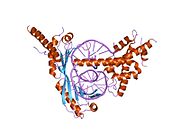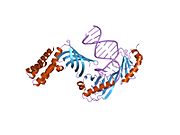TATA-binding protein
Ensembl | |||||||||
|---|---|---|---|---|---|---|---|---|---|
| UniProt | |||||||||
| RefSeq (mRNA) | |||||||||
| RefSeq (protein) | |||||||||
| Location (UCSC) | Chr 6: 170.55 – 170.57 Mb | Chr 17: 15.72 – 15.75 Mb | |||||||
| PubMed search | [3] | [4] | |||||||
| View/Edit Human | View/Edit Mouse |
| TBP | |||||||||
|---|---|---|---|---|---|---|---|---|---|
| |||||||||
The TATA-binding protein (TBP) is a
TBP gene family
TBP is a member of a small gene family of TBP-related factors.
Role as transcription factor
TBP is a subunit of the eukaryotic
Binding of TFIID to the
TBP is also important for transcription by RNA polymerase I and RNA polymerase III, and is therefore involved in transcription initiation by all three RNA polymerases.[12]
TBP is involved in
Another distinctive feature of TBP is a long string of glutamines in the N-terminus of the protein. This region modulates the DNA binding activity of the C-terminus, and modulation of DNA-binding affects the rate of transcription complex formation and initiation of transcription. Mutations that expand the number of CAG repeats encoding this
DNA-protein interactions
When TBP binds to a TATA box within the DNA, it distorts the DNA by inserting amino acid side-chains between base pairs, partially unwinding the helix, and doubly kinking it. The distortion is accomplished through a great amount of surface contact between the protein and DNA. TBP binds with the negatively charged phosphates in the DNA backbone through positively charged lysine and arginine amino acid residues. The sharp bend in the DNA is produced through projection of four bulky phenylalanine residues into the minor groove. As the DNA bends, its contact with TBP increases, thus enhancing the DNA-protein interaction.
The strain imposed on the DNA through this interaction initiates melting, or separation, of the strands. Because this region of DNA is rich in
TBP's C-terminus composes of a helicoidal shape that (incompletely) complements the T-A-T-A region of DNA. This incompleteness allows DNA to be passively bent on binding.
For information on the use of TBP in cells see: RNA polymerase I, RNA polymerase II, and RNA polymerase III.
Protein–protein interactions
TATA-binding protein has been shown to interact with:
- BRF1,[14][15]
- BTAF1,[16][17]
- C-Fos,[18]
- C-jun,[19]
- EDF1,[20][21][22]
- TFIIH subunit 4),[16]
- Mdm2,[30][31]
- NFYB,[35]
- P53,[36][37]
- PAX6,[37]
- POLR2A,[16]
- POU2F1,[38]
- RELA,[39][40]
- NR2B1,[41]
- TAF1,[35][42][43][44]
- TAF4,[45]
- TAF5,[35][43][46]
- TAF6,[35][43][45]
- TAF7,[35][45]
- TAF9.[35][47]
- TAF10,[35][43]
- TAF11,[35][48][49]
- TAF13,[48] and
- TAF15.[50]
Complex assembly
The TATA-box
Structure
The C-terminal core of TBP (~180 residues) is
.References
- ^ a b c GRCh38: Ensembl release 89: ENSG00000112592 – Ensembl, May 2017
- ^ a b c GRCm38: Ensembl release 89: ENSMUSG00000014767 – Ensembl, May 2017
- ^ "Human PubMed Reference:". National Center for Biotechnology Information, U.S. National Library of Medicine.
- ^ "Mouse PubMed Reference:". National Center for Biotechnology Information, U.S. National Library of Medicine.
- PMID 17670940.
- PMID 21711503.
- PMID 11092823.
- PMID 22723752.
- ^ PMID 30819819.
- S2CID 22205897.
- PMID 20495556.
- PMID 22365827.
- ^ "Entrez Gene: TBP TATA box binding protein".
- PMID 10921893.
- PMID 7624363.
- ^ PMID 9159119.
- PMID 9488487.
- PMID 8065335.
- PMID 7848298.
- PMID 12040021.
- PMID 10816571.
- PMID 10567391.
- ^ PMID 8577725.
- S2CID 36598301.
- PMID 7724559.
- PMID 9603936.
- PMID 7958900.
- PMID 7590250.
- PMID 9482861.
- PMID 9271120.
- PMID 9388200.
- PMID 10215616.
- PMID 9111364.
- PMID 8700832.
- ^ PMID 9153318.
- PMID 1465435.
- ^ PMID 10359315.
- PMID 8202368.
- PMID 9584164.
- PMID 7706261.
- PMID 7667283.
- PMID 9858607.
- ^ S2CID 4364676.
- PMID 9660973.
- ^ S2CID 24519687.
- PMID 9045704.
- PMID 11564863.
- ^ PMID 7729427.
- PMID 8670810.
- PMID 8663456.
- PMID 12782648.
- PMID 10974559.
- OCLC 789601172.
- PMID 27007846.
- PMID 12878007.
- S2CID 4307043.
External links
- GeneReviews/NCBI/NIH/UW entry on Spinocerebellar Ataxia Type 17
- Interactive TBP Structure at massey.ac.nz
- PDB Molecule of the Month TATA-binding protein
- TATA-Box+Binding+Protein at the U.S. National Library of Medicine Medical Subject Headings (MeSH)
- FactorBook TBP
- Overview of all the structural information available in the PDB for UniProt: P20226 (Human TATA-box-binding protein) at the PDBe-KB.





